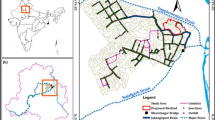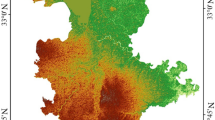Abstract
A daily-process hydrological simulation model was developed according to the principles of water balance, with the requirements of navigation, flood control and water regulation of the planned connected wetlands. Four aspects of the wetlands were analyzed, namely the recharge-discharge relationship between surface water and groundwater, environmental water requirements, constructed wetland purification, and timely water diversion. The water sources of the connected wetlands in the subsidence area were also calculated. The daily-process model was used for different hydrological years to simulate the connected wetlands, including aspects such as navigation guarantee, flood control and available regulated water resources. Based on the study results, the following conclusions were made: (i) Water diversion from rivers may be used for water utilization, and navigation may be satisfied in normal years. (ii) A certain amount of water diversion is required to supply the wetlands and to maintain navigation in consecutive dry years. However, a small amount of water remains which may be utilized when the water originates from wetland purification and water diversion on appropriate occasions. (iii) The simulation of flood risk based on hourly analysis showed that the connected area is capable of preventing the threat of a 50-year flood.



















Similar content being viewed by others
References
Amoros C, Bornette G (2002) Connectivity and biocomplexity in waterbodies of riverine floodplains. Freshwater Biology 47:761–776
Bohnet I, Smith DM (2007) Planning future landscapes in the Wet Tropics of Australia: a social–ecological framework. Landscape and Urban Planning 80:137–152
Bornette G, Amoros C, Lamouroux N (1998) Aquatic plant diversity in riverine wetlands: the role of connectivity. Freshwater Biology 39:267–283
Bulut Z, Yilmaz H (2009) Determination of waterscape beauties through visual quality assessment method. Environmental Monitoring and Assessment 154:459–468
Buuren M (1991) A hydrological approach to landscape planning: the framework concept elaborated from a hydrological perspective. Landscape and Urban Planning 21:91–107
Castaño SC, Santos PM, Alfaro PEM (2008) Evaluating infiltration losses in a Mediterranean wetland: Las Tablas de Daimiel National Park, Spain. Hydrological Processes 22(26):5048–5053
Catherine MP (2001) Hydrologic connectivity and the management of biological reserves: a global perspective. Ecological Applications 11:981–998
Choi J, Harvey JW (2000) Quantifying time-varying ground-water discharge and recharge in wetlands of the northern florida Everglades. Wetlands 20(3):500–511
Douglas AG, Richard GW, Robert AY (1981) Option value: empirical evidence from a case study of recreation and water quality. Quarterly Journal of Economics 96:657–673
Eckbo G (1990) Water in total landscape design. In: Tsuru K (ed) Elements and total concept of waterscape design. Documents held in the Kunstgeschichte Bibliothek, Berlin. 3
Joe BS (1966) Recreation benefits from water pollution control. Water Resources Research 2:167–182
John MW (1988) Water in the landscape. Landscape and Urban Planning 16:145–162
Krasnostein AL, Oldham CE (2004) Predicting wetland water storage. Water Resources Research 40, W10203
Lee SW, Hwang SJ, Lee SB, Hwang HS, Sung HC (2009) Landscape ecological approach to the relationships of land use patterns in watersheds to water quality characteristics. Landscape and Urban Planning 92:80–99
Masoner JR, Stannard DI (2010) A comparison of methods for estimating open-water evaporation in small wetlands. Wetlands 30(3):513–524
Matrai IG, Lakatos AC, Szlavik L (2011) Forecast of changes concerning the water budget in a wetland of Danube floodplain. Journal of Environmental Science & Engineering 5(5):523–532
Matthew G (2004) Rethinking urban metabolism: water, space and the modern city. City 8:363–379
Meselhe EA, Arceneaux JC, Waldon MG (2010) Water budget model for a remnant northern Everglades wetland. Journal of Hydraulic Research 48(1):100–105
Morison PJ, Brown RR (2011) Understanding the nature of publics and local policy commitment to Water Sensitive Urban Design. Landscape and Urban Planning 99:83–92
Owen CR (1995) Waterbudget and flow patterns in an urban wetland. Journal of Hydrology 169(1–4):171–187
Randall JH, John FW, David PK (1999) Characterizing hydrology and the importance of ground-water discharge in natural and constructed wetlands. Wetlands 19(2):458–472
Rayburg S, Thoms M (2009) A coupled hydraulic-hydrologic modelling approach to deriving a water balance model for a complex floodplain wetland system. Hydrology Research 40(4):364–379
Richardson M, Ketcheson S, Whittington P, Price J (2012) The influences of catchment geomorphology and scale on runoff generation in a northern peatland complex. Hydrological Processes 26(12):1805–1817
Roulet NT (1990) Hydrology of a headwater basin wetland: groundwater discharge and wetland maintenance. Hydrological Processes 4(4):387–400
Santos AM, Thomaz SM (2007) Aquatic macrophytes diversity in lagoons of a tropical floodplain: the role of connectivity and water level. Austral Ecology 32:177–190
Scholz M, Yang Q (2010) Guidance on variables characterising water bodies including sustainable flood retention basins. Landscape and Urban Planning 98:190–199
Tennant DL (1976) Instream flow regimes for fish, wildlife, recreation and related environmental resources. Fisheries 1(4):6–10
Walton R, Chapman RS, Davis JE (1996) Development and application of the wetlands Dynamic Water Budget Model. Wetlands 16(3):347–357
Wang J, Liu Y, Guo H, Mao G, Fan Y (2005) Ecological landscape architecture and designing of urban water systems. Urban Environment &Urban Ecology 18:4–6
Yang G, Laura CB, Keith AC, Bryan CP (2011) The impact of urban development on hydrologic regime from catchment to basin scales. Landscape and Urban Planning 103:237–247
Yu K, Zhang L (2008) Preservation and development of water cities adaptive to the areas flooded by the Yellow River. Journal of Hydraulic Engineering 39:688–696
Acknowledgments
This study was funded by Project 40830637, which is supported by the National Natural Science Foundation of China and National Science and Technology Ministry (ID: 2007BAC28B00).
Author information
Authors and Affiliations
Corresponding author
Rights and permissions
About this article
Cite this article
Zhang, Q., Wang, F. & Chen, M. Study on Wetland Connectivity Technology in the Urban Coalmine Subsidence Area of Huaibei, China—Hydrological Guarantee Analysis. Wetlands 34, 841–852 (2014). https://doi.org/10.1007/s13157-014-0547-9
Received:
Accepted:
Published:
Issue Date:
DOI: https://doi.org/10.1007/s13157-014-0547-9




